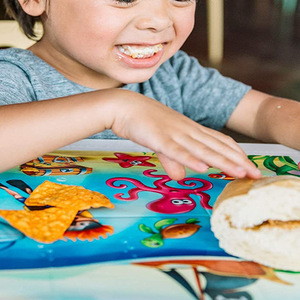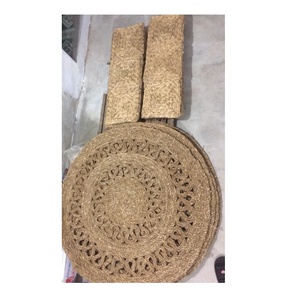(4384 products available)

























































































































































































































Placemats on table are used as a protective barrier to shield the table's surface from damage caused by dishes, spills, or heat. They are both functional and decorative elements that enhance dining experiences. Here are some common types of placemats:
Woven:
Woven placemats are made of materials like rattan, seagrass, or bamboo. They are woven into a tight pattern, creating a durable and textured surface. The woven design adds a touch of natural beauty to the table setting. These placemats are easy to clean and maintain, making them practical for everyday use. They provide a rustic charm and a non-slip surface, helping to keep dishes in place.
Fabric:
Fabric placemats are made from various fabrics, including cotton, linen, and polyester blends. They come in many colors, patterns, and designs, making them versatile and stylish. Fabric placemats are soft and absorbent, providing a comfortable dining experience. They are washable and easy to care for, but they may need more frequent ironing to keep them wrinkle-free.
Vinyl:
Vinyl placemats are made from a type of synthetic material. They are popular for their durability and easy-to-clean surface. Vinyl placemats come in various colors and designs, including printed patterns and textures. They can be easily wiped clean with a damp cloth, making them ideal for messy eaters or outdoor dining. Vinyl placemats are water-resistant and can withstand spills without soaking in.
Wood:
Wooden placemats are crafted from materials like bamboo, teak, or acacia. They provide a sturdy and elegant surface for dining. Wooden placemats have a natural, warm look that adds sophistication to the table. They are easy to clean and maintain, but regular oiling may be necessary to keep the wood's condition. Wooden placemats are heat-resistant, making them suitable for hot dishes.
Marble:
Marble placemats are luxurious and sophisticated. They are made from solid marble or have a marble-like finish. These placemats are elegant and eye-catching, adding a touch of class to any table setting. Marble placemats are easy to clean and maintain. They can resist high temperatures, making them ideal for hot pots and pans. However, they are heavy and may require more care to prevent scratching the table surface.
Materials:
Fabric placemats are usually made of cotton or linen. These two materials are strong and can be washed in a machine. Some fabric place mats are made of silk, but silk is a delicate material and can easily get damaged. Therefore, silk placemats usually need to be hand washed only. Leather placemats are made of real leather or artificial leather, also known as leatherette. It is more eco-friendly and affordable than real leather. The glass used in glass placemats is usually tempered glass, which is stronger and less likely to break. Wooden placemats are made of bamboo or acacia wood. Both are sturdy and water-resistant. Acrylic is a type of plastic that can be recycled. Acrylic placemats are lightweight and come in many different colors.
Shapes and Sizes:
Rectangle placemats are the most common and will fit most tables and place settings. They work well for breakfast, lunch, and dinner meals. Round placemats are suitable for circular tables or square tables. They also look nice for cocktail parties or informal meals. Square placemats work well for square tables and are great for informal and formal meals. Oval placemats are unique and can add a touch of elegance to the dining table. They work well for both informal and formal meals. Runner placemats are long and narrow, similar to a table runner. They can be placed in the center of the table across its width or length and work well for buffet-style meals or when several dishes are served.
Design Elements:
Many fabric placemats have patterns printed or woven into them. Some patterns are plain, while others are more complex, with checks, stripes, and floral designs. The edges of fabric placemats can have special treatments like hemming or piping. Leather placemats may have textures or patterns pressed into them. Glass placemats can have artwork or designs sandwiched between the glass layers. Wooden placemats may have their edges shaped or cut in special ways. Acrylic placemats often have bold, bright colors since acrylic can be dyed in nearly any color.
Dining table placemats are used in many settings and industries.
Restaurants
Restaurants use placemats to enhance their branding and customer experience. Logo placemats can advertise the restaurant brand and make the logo more memorable. Placemats can also be used to advertise new dishes, drinks, or desserts. In fast-food restaurants or buffet restaurants, instructional placemats can guide customers on how to place their trays or plates. In addition, play placemats can make the dining experience more enjoyable for children.
Hotels and Resorts
Hotels and resorts can use placemats in their restaurants, room service, or banquet facilities. They can use placemats to showcase the local culture, highlight the hotel or resort brand, and provide information about the facilities and services available.
Catering and Event Planning
Caterers and event planners can use placemats to customize table settings for different events. They can use placemats to match the theme and color scheme of the event, showcase the event branding, and provide guests with information about their seating arrangements.
Food Industry
The food industry can use placemats to promote products and provide information to consumers. Food brands can use placemats in supermarkets and food courts to showcase their products and provide information about their ingredients, nutritional value, and cooking instructions.
Educational Institutions
Educational institutions can use placemats to promote learning and provide information to students. Schools and universities can use instructional placemats in their dining halls to promote good manners and healthy eating habits. Moreover, educational placemats can be used in preschool and kindergarten to promote language learning, math skills, and social skills.
Corporate Offices
Corporate offices can use placemats in their cafeterias and dining areas. They can use placemats to convey the company values, mission statement, and employee recognition. They can also use placemats to provide information about health and wellness programs, diversity and inclusion initiatives, and professional development opportunities.
Wholesale buyers need to consider multiple factors when selecting placemats for the table. They should ensure that the placemats meet the needs of their customers. Here are some key factors to consider:
Material & Durability:
First, define the target market and use scenarios. If the customers are upscale restaurants and hotels, then select placemats made from cloth or premium materials. These materials can be acrylic, PVC or vinyl for mass-market diners. The selections should have a long lifespan and be easy to clean.
Size & Shape:
Consider the standard sizes and shapes of tables and chairs in the target market. Ensure that the placemats will fit well on the tables. For example, rectangular placemats go well with rectangular tables. Round placemats match up with round tables. Consider the storage space for the placemats. Smaller placemats are more convenient to store.
Design & Color:
Choose classic designs and neutral colors, which have a broad appeal. For example, black, white, and beige colors are usually popular. Placemats with simple patterns and textures are also widely accepted. Keep the target customers' preferences in mind. For example, rustic patterns and earth tones are favored by those who want farmhouse décor. Multicolored designs are preferred by customers who want modern or eclectic interiors.
Ease of Cleaning:
The target customers will also want to know how easily the placemats are cleaned. Placemats made from durable materials are easy to wipe clean or wash. They are more suitable for commercial use.
Environmental Considerations:
Consider using recyclable and biodegradable materials. They will appeal to customers who are concerned about sustainability. They want to keep their brand image clean.
Price & Profitability:
Analyze the production costs and the prices of similar products. Ensure that the wholesalers can make a profit. While the price is important, do not compromise the quality. The quality must be good enough to satisfy the end users.
Q1: What is the point of placemats?
A1: Placemats are used to protect the dining table from stains, scratches, and damage. They are decorative and provide a designated space for each diner, helping to organize tableware.
Q2: What do people put on tables?
A2: People put various things on their tables, including centerpieces, coasters, utensils, decorative items, and placemats on the table.
Q3: How should placemats be placed?
A3: Placemats should be placed in such a way that they face the center of the table. Generally, it is recommended that they be placed about 18 inches from the center of the table.
Q4: Do placemats go under the chargers?
A4: Yes, placemats usually go under the chargers. In this case, the charger will be the first thing placed on the placemat.